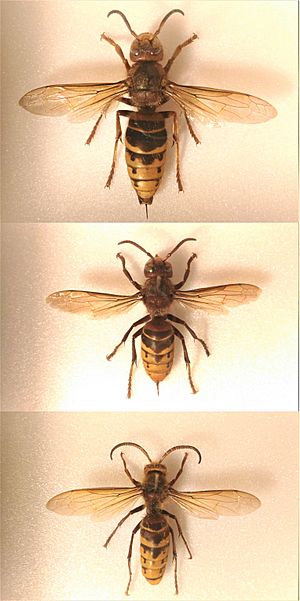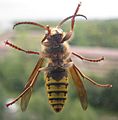European hornet facts for kids
Quick facts for kids European hornet |
|
|---|---|
 |
|
| Queen (top), worker (middle) and male (bottom) of the germana subspecies | |
| Scientific classification |
The European hornet (Vespa crabro) is a very large wasp. It lives in Europe and is the only true hornet found in North America. These hornets are known for living in big, organized groups.
They build amazing nests from plant material and other fibers. They chew these materials to make a special paper-like substance.
European hornets usually try to avoid people. But they will sting if they feel threatened. This can happen if their nest is disturbed or if they are stepped on. They also protect their food sources very fiercely.
These hornets mostly eat large insects. Their favorite foods include other wasps and big bees.
A European hornet's sting can be quite painful. The pain might last for a few days, and the area can swell up. It's always best to be careful around them.
Contents
What is a European Hornet?
The European hornet is the biggest wasp in Europe. It can grow up to 3.5 centimeters (1.4 inches) long. These hornets are part of a group called eusocial insects. This means they live together in a colony with different jobs for each member. There is a queen, many workers, and males.
Where Do European Hornets Live?
European hornets are native to Europe. But they were brought to North America in the 1800s. Now, they can be found in many parts of the eastern United States. They usually live in forests and wooded areas. They like places where they can find trees to build their nests.
Building a Hornet Nest
European hornets are expert builders. They create large, paper-like nests. They make this "paper" by chewing wood fibers. They mix the wood with their saliva. These nests are often found in hollow trees or inside walls. Sometimes, they build nests in attics or sheds. A nest can become very large, holding hundreds of hornets.
What Do Hornets Eat?
European hornets are predators. This means they hunt other insects for food. They are especially fond of large insects like grasshoppers and crickets. They also eat other wasps and bees. Sometimes, they will even hunt caterpillars. Hornets also enjoy sweet things. They might feed on fruit juices or tree sap.
Hornet Behavior and Stings
European hornets are generally not aggressive unless provoked. They are very protective of their nest. If you get too close, they might see you as a threat. Their sting is painful, but it is rarely dangerous unless someone is allergic. If you see a hornet, it's best to stay calm and move away slowly. Do not try to swat at it.
Images for kids
See also
 In Spanish: Avispón europeo para niños
In Spanish: Avispón europeo para niños










